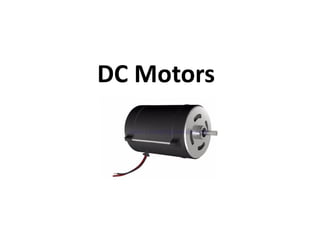DC Motors
- 1. DC Motors
- 2. • In this tutorial, we will logically understand the operation and construction of a commercial DC motor. • let’s first start with the simplest DC motor possible, the stator provides a constant magnetic field on the armature of rotor which is the rotating part, a simple coil. The armature is connected to a DC power source through a commutator rings.
- 3. • When the current flows to the coil, an electromagnetic force is induced on it according to the Lorentz’s law. • So, the coil will start to rotate. • In physics, particularly electromagnetism, the Lorentz force is the combination of electric and magnetic force on a point charge due to electromagnetic fields. If a particle of charge q moves with velocity v in the presence of an electric field E and a magnetic field B, then it will experience a force
- 4. • Variations on this basic formula describe the magnetic force on a current-carrying wire (sometimes called Laplace force). • The force F acting on a particle of electric charge q with instantaneous velocity v, due to an external electric field E and magnetic field B, is given by . • Here, we see Lorentz force F on a charged particle (of charge q) in motion (instantaneous velocity v). The E field and B field vary in space and time.
- 5. • As the coil rotates, the commutator rings connect with the power source of opposite polarity. As a result, on the left side of the coil, the electricity will always flow away, and on the right side, electricity will always flow towards.
- 6. • This ensures that the torque action is always in the same direction throughout the motion, so the coil will continue rotating. But, if you observe the torque action on the coil closely, you will notice that, when the coil is nearly perpendicular to the magnetic flux, the torque action nears 0.
- 8. • As a result, there will be an irregular motion of the rotor if you run a such DC motor. Here is the trick to overcoming this problem, add 1 more loop to the rotor with a separate commutator for it. • In this arrangement, when the 1st loop is on verticular position, the 2nd loop will be connected to the power source. So a magnetic force will be always presented in the system.
- 9. • More over, the more such loops the smoother will be the rotor rotation. In practical motor, the armature loops are feeding inside slots of highly permeable steel layers. This will enhance magnetic flux in reaction, brushes help to maintain contact with the power source.
- 10. • A permanent magnet stator pole is used only for very small DC motors, most often an electromagnet is used. The field coil of the electromagnet is powered from the same DC source, the field coils can be connected to the rotor windings in 2 different ways: Parallel or Series. • The results is 2 different kind of DC motor constructions, a shunt and a series motor. The series one has good starting torque but its speed slows down with the load.
- 13. • The shunt motor has a low starting torque but it’s able to run almost in constant speed, in respective of the load acting in the rotor. • Unlike the other electrical machines, DC motors exibly unique caracteristic: the production of back e.m.f. • A rotating loop in magnetic field will produce an e.m.f according to the principle of electromagnetic induction, the case of rotating armature loop is always the same. An internal e.m.f will be induced that opposes the applied input voltage according to Lenz’s law.
- 15. • The back e.m.f reduces armature current by a large amount, back e.m.f is proportional to the speed of the rotor. At the starting of the motor, back e.m.f is too low thus the armature current becomes too high. Leading to the burn out of the rotor; so, a propre starting mechanism that controls the applied input voltage is necessary in large DC motors.
- 16. • One of the interesting varitions in a DC motors is the universal motors, which is capable to run in both AC and DC power sources. • To know more about it, please check universal motor.
- 17. • Thank you.
















